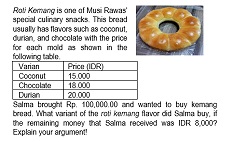Mathematics PISA Problems Using Local Context for Elementary School Students
DOI:
https://doi.org/10.31629/jg.v8i1.5604Keywords:
development research, PISA model, mathematics problems, local contextsAbstract
Referring to the results of an international survey, one of which is PISA, the achievements of Indonesian students are still below the global average score. The main problem that is the causative factor is that students need to be used to solving similar problems. The issues used in PISA questions are familiar to only some students in Indonesia. This study aimed to develop PISA model mathematical problems with valid and reliable local contexts and potential impacts. The type of research conducted is development research using the ADDIE model with the stages of analysis, design, development, and evaluation. The test subjects were fifth-grade elementary school students in Bengkulu and South Sumatra provinces. The research instruments were product development validity sheets, legibility sheets, and student response questionnaires. Data analysis consisted of validity analysis using the Aiken Index and reliability with Cronbach Alpha. The study results show that PISA model mathematical questions with the regional context meet the validity, reliability, and potential impact criteria. The results of the implementation test showed that 11 students (27.50%) were in the low category, 32 students (55.00%), and 7 students (17.50%) were in the high category.
Downloads
References
Adilaturrahmah, F., & Suparni, S. (2021). Penerapan pendekatan matematika realistik pada materi bangun datar melalui kebudayaan kampung kuta. Jurnal Gantang, 6(2), 125-132.
Bindas, N. ., Barasandji, S., & Efendi, E. (2010). Peningkatan keterampilan siswa membaca nyaring melalui metode latihan terbimbing pada siswa kelas III SDN Paranonge. Jurnal Kreatif Online, 4, 4.
Charmila, N., Zulkardi, Z., & Darmawijoyo, D. (2016). Pengembangan soal matematika model pisa menggunakan konteks jambi. Jurnal Penelitian dan Evaluasi Pendidikan, 20(2), 198–207.
Dasaprawira, M. N., & Susanti, E. (2019). Developing mathematics questions of pisa type using bangka context. Journal on Mathematics Education, 10(2), 303-314.
Direktoratdikdas. (2022). Mengkaji kembali hasil pisa sebagai pendekatan inovasi pembelajaran untuk peningkatan kompetensi literasi dan numerasi. Direktorat Guru Pendidikan Dasar.
Kadir, K., & Masi, L. (2013). Penggunaan konteks dalam pembelajaran matematika untuk menigkatkan keterampilan sosial siswa SMP. In In Proceeding KNPM V Malang. Malang.
Kemendikbud. (2014). Peraturan Menteri Pendidikan dan Kebudayaan, Nomor 58, Tahun 2014, tentang Kurikulum 2013 Sekolah Menengah Pertama (SMP)/Madrasah Tsanawiyah (MTs).
Kemendikbud, P. (2022). Asesmen Kompetensi Minimum. Pusat Asesmen Pendidikan Kemendikbudristek [Minimum competency assessment. Center for Education Assessment of the Ministry of Education and Culture.
Mulyatna, F., Karim, A., & Wiratomo, Y. (2022). Eksplorasi kembali etnomatematika pada jajanan pasar di daerah Cileungsi. Cartesian: Jurnal Pendidikan Matematika, 1(2), 76-84
Octaria, D. (2018). Soal matematika pisa menggunakan konteks budaya ogan ilir tingkat sekolah menengah pertama. Jurnal Dosen Universitas PGRI Palembang. Prosiding Dosen Universitas PGRI Palembang Edisi 18
Pratiwi, I., & Putri, R. I. I. (2019). Long jump in asian games: context of pisa-like mathematics problems. Journal on Mathematics Education, 10(1), 81-92.
Rauf, A., Fitriasari, P., & Septiani, M. A. (2022). Pengembangan soal matematika model pisa dengan menggunakan konteks budaya palembang. Jurnal Edukasi Matematika dan Sains, 10(2), 265–276.
Retnawati, H. (2014). Proving the Validity of the Instrument in the Measurement. Diambil dari http://www.evaluationedu.com
Rezeki, S., Andrian, D., & Safitri, Y. (2021). Mathematics and cultures: a new concept in maintaining cultures through the development of learning devices. International Journal of Instruction, 14(3), 375–392.
Setiana, D. S., & Nuryadi, N. (2021). Analisis efektivitas e-lkpd (lembar kegiatan peserta didik elektronik) berbasis etnomatematika batu akik ditinjau dari kemampuan awal siswa. Jurnal Gantang, 6(2), 113-123.
Simamora, R. ., & Saragih, S. (2019). Improving student’s mathematical problem solving ability and self-efficacy through guided discovery learning in local culture context. Journal of Mathematics Education, 14(1), 61–72.
Stroyer, A. ., Nainggolan, J., & Hutabarat, I. . (2018). Exploration of ethnomathematics of house and traditional music tools biak-papua cultural. Jurnal Ilmiah Pendidikan MIPA, 8(3), 175–184. https://doi.org/http://dx.doi.org/10.30998/formatif.v8i3.2751’
Sugiyono. (2016). Metode penelitian kuantitatif, kualitatif dan R&D. Bandung: PT Alfabet.
Surya, E., & Saragih, S. (2017). Development of learning devices based on contextual teaching and learning model based on the context of aceh cultural to improve mathematical representation and self-efficacy ability of SMAN 1 Peureulak students. Journal of Education and Practice, 8(27), 171–186.
Susanta, A., Sumardi, H., & Susanto, E. (2023). Mathematics literacy task on number pattern using bengkulu context for junior high school students. Journal on Mathematics Education, 14(1), 85–102. https://doi.org/http://doi.org/10.22342/jme.v14i1.pp85-10
Susanta, A., Sumardi, H., & Zulkardi. (2022). Development of e-module using bengkulu contexts to improve literacy skills of junior high school students. Jurnal Pendidikan Matematika, 16(2), 171–186.
Susanta, A., Susanto, E., & Sumardi, H. (2022). The development of hots-based mathematical problem using local context for senior high school. AKSIOMA: Jurnal Program Studi Pendidikan Matematika, 11(4).
Susanta, A., Sumardi, H., Susanto, E., & Retnawati, H. (2023). Mathematics literacy task on number pattern using Bengkulu context for junior high school students. Journal on Mathematics Education, 14(1), 85-102.
Susanta, A., Koto, I., & Susanto, E. (2022). Teachers' ability in writing mathematical literacy module based on local context. Education Quarterly
Susanti, E. (2016). Development of timss-type math problems using traditional house contexts for junior high school students. Jurnal Pendidikan Matematika, 10(2), 53–74.
Susanto, E., & Retnawati, H. (2016). Perangkat pembelajaran matematika bercirikan pbl untuk mengembangkan hots siswa SMA. Jurnal Riset Pendidikan Matematika, 3(2), 189–197. Diambil dari http://journal.uny.ac.id/index.php/jrpm
Susanto, E., Rusdi, & Susanta, A. (2021). Pembelajaran matematika realistik berbasis budaya masyarakat bengkulu dalam meningkatkan komunikasi matematis mahasiswa. Jurnal Pendidikan Matematika Raflesia, 6(1), 39–49.
Susanto, E., Fransiska, H., & Susanta, A. (2023). Students’ numerical ability on minimum competency assessment in junior high school. International Journal of Trends in Mathematics Education Research, 6(1), 47-53.
Wardani, A. ., Sulkardi, & Hartono, Y. (2017). Pengembangan soal matematika model pisa level 5 untuk program pengayaan smp. Jurnal Pendidikan Matematika Rafa, 1–18.
Ylimaki, R. (2010). Towards a Neo-Vygotskian Approach to 21st Century Learning.
Zulkardi. (2013). Designing joyful and meaningful new school mathematics using indonesian realistic mathematics education. Southeast Asian Mathematics Education Journal, 3(1), 17–25. Diambil dari http://repository.unsri.ac.id/id/eprint/6307

Downloads
Published
Issue
Section
License
Copyright (c) 2023 Jurnal Gantang

This work is licensed under a Creative Commons Attribution-NonCommercial-ShareAlike 4.0 International License.

















